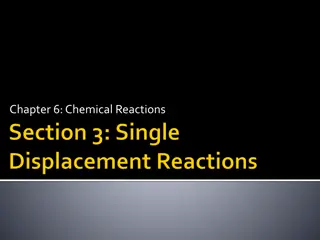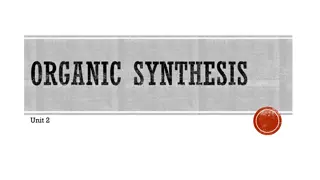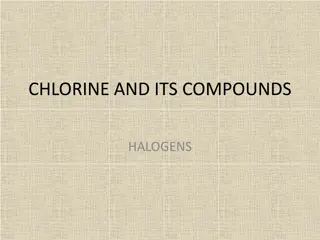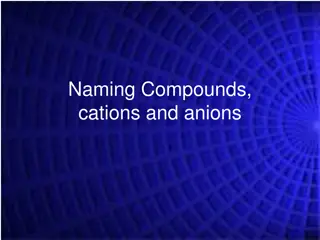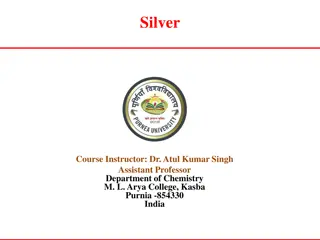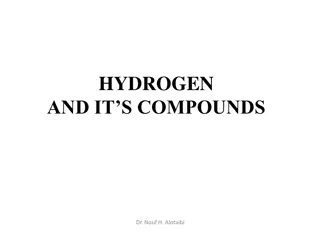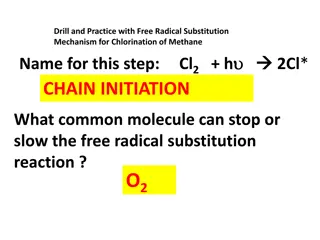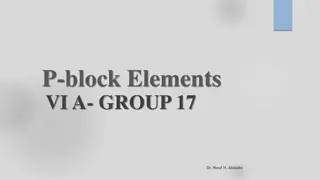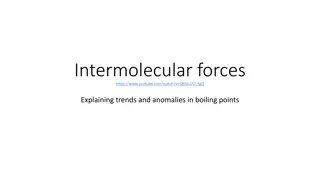Advancements in Chemical Mechanisms for Air Quality Management
Daniel Jacob and team have been enhancing chemical mechanisms in the GEOS-Chem model to support US air quality management. Ongoing work includes developing new mechanisms for aromatic VOCs, tropospheric halogens, mercury redox, adaptive mechanism reduction, machine learning applications, and unifica
0 views • 19 slides
Understanding Single Displacement Reactions in Chemistry
Learn about single displacement reactions in chemistry where one element displaces another in a compound. Explore the general equation, reactivity differences, activity series, and predictions for various scenarios, including halogens and metals. Discover how to identify likely elements to swap and
1 views • 13 slides
Understanding Alkane Reactivity: Bond Fission and Halogenation
Alkanes, known for their low reactivity, can undergo halogenation in the presence of sunlight or UV light to form halogenoalkanes. This reaction is significant due to the non-polar nature of alkane bonds and highlights a rare reactivity pathway for these compounds. The process of bond fission, parti
0 views • 135 slides
Chlorine and Halogens: Properties, Reactions, and Industrial Uses
Halogens, including chlorine, are in group 7 of the periodic table and have 7 electrons in their outer shell. They easily form negative ions by gaining an electron. Chlorine is symbolized as Cl and has two isotopes, 37Cl and 35Cl, with an electronic arrangement of 2:8:7. It can be prepared in the la
4 views • 31 slides
Essential Information on Naming Compounds, Cations, and Anions
Learn about the essential elements, symbols, and polyatomic ions you need to know for naming compounds correctly. Understand rules for naming compounds when elements combine, including diatomic molecules, halogens, oxygen, and sulfur. Explore polyatomic ions with different charges and their names to
0 views • 12 slides
Chemical Properties and Uses of Silver: A Comprehensive Overview
Dr. Atul Kumar Singh, Assistant Professor at M.L. Arya College, provides detailed information on the chemical properties of silver, including its reactions with air, halogens, acids, alkali cyanides, alkalis, and sulphur. The text also highlights the various uses of silver in coinage, ornaments, and
0 views • 7 slides
Exploring Hydrogen and Its Compounds: Properties and Isotopes
Hydrogen, the most abundant element in the universe, has unique properties that make it resemble both alkali metals and halogens. It exists mainly in combined states, except in volcanic gases, and its isotopes exhibit distinct chemical and physical characteristics. The ionization energy of the H-H b
0 views • 37 slides
Understanding Mass Spectrometry Principles and Applications
Mass spectrometry is a powerful analytical technique used to determine the molecular mass, formula, and structural features of compounds. By ionizing molecules in a mass spectrometer, it generates molecular ions that reveal valuable information about the composition of the compound. Isotope peaks he
0 views • 33 slides
Free Radical Substitution Mechanism in Methane Chlorination
Explore the detailed steps of the free radical substitution mechanism in the chlorination of methane, including chain initiation, propagation, and termination. Learn about the role of common molecules like O2 in slowing or stopping the reaction and discover how radical-radical recombination reaction
0 views • 10 slides
Characteristics and Families of the Periodic Table: A Comprehensive Overview
Explore the characteristics of the periodic table including the alkali metals, alkaline earth metals, transition metals, lanthanides, actinides, and more. Learn about the properties, valence electrons, and uses of different groups, such as the boron group, carbon group, nitrogen group, oxygen group,
0 views • 8 slides
The Halogens: Properties and Uses of Fluorine, Chlorine, Bromine, Iodine, and Astatine
The halogens are a group of non-metals in the periodic table with seven electrons in their outer shell, making them highly reactive. This article discusses the properties and uses of fluorine, chlorine, bromine, iodine, and astatine. Fluorine is utilized in toothpaste, chlorine is commonly used as a
0 views • 13 slides
Group 17 Elements: The Halogens and Their Properties
Group 17 elements, known as the Halogens, include fluorine (F), chlorine (Cl), bromine (Br), iodine (I), and astatine (At). They exhibit unique properties such as small atomic radii, high ionization energy, and strong oxidizing power. The halogens form diatomic molecules and have varying electron co
0 views • 19 slides
Understanding Boiling Points and Intermolecular Forces
Exploring the relationship between intermolecular forces and boiling points, this content discusses trends and anomalies in boiling points of halogens, isomers with the same molecular formula, molecules with similar Mr, and polar molecules. It explains how molecular size, structure, and interactions
0 views • 5 slides
Understanding Halogens: Properties, Reactivity, and Applications
Halogens are a group of reactive non-metals in the periodic table with unique properties. They have seven electrons in their outer shell, enabling them to easily form ions by gaining one electron. Due to their reactivity, halogens are commonly found in nature as salts, and their name reflects their
0 views • 32 slides

